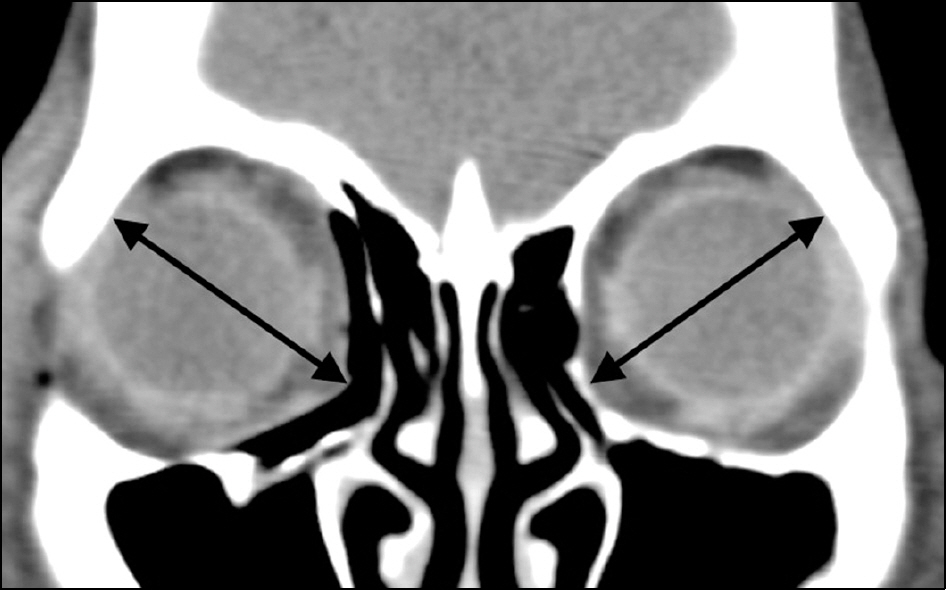J Korean Ophthalmol Soc.
2013 Sep;54(9):1315-1320.
Repair of Inferomedial Orbital Wall Fractures with Bony Strut Loss by Overlapping Absorbable Copolymer
- Affiliations
-
- 1Department of Ophthalmology, Ajou University School of Medicine, Suwon, Korea. drkook@ajou.ac.kr
Abstract
- PURPOSE
To report the results of surgical repairing of inferomedial orbital wall fractures accompanied with loss of bony strut by an overlapping method using Resorb X(R) plates (poly(D,L)-lactic acid).
METHODS
To repair inferomedial orbital wall fractures with loss of bony strut, we bent the medial aspect of the plate for floor fracture according to the anatomical structure and then inserted the floor implant, which was supported by anterior, posterior and lateral margins of the floor fracture. Then, the medial implant, which was supported by the bent medial edge of the floor implant, was inserted. Postoperatively, we analyzed the outcomes of 21 patients regarding postoperative enophthalmos, limitation of eye movement (LOM) and diplopia. The diagonal lengths of the orbit in the operated side were compared with the non-traumatized side based on the coronal view of the postoperative CT scans to determine the success or failure of the reconstruction.
RESULTS
The average postoperative enophthalmic value was 0.5 mm, and no significant differences between the orbital diagonal lengths of the operated and non-operated eyes were observed. The LOM shown in 7 out of 8 patients was completely resolved during the postoperative follow-up period. All patients with diplopia, including one patient who showed partial remission of LOM, experienced complete symptom resolution. No other complications related to the implant were recorded.
CONCLUSIONS
Inferomedial orbital wall fractures with the loss of bony strut can be successfully repaired by the overlapping method using Resorb X(R) implants.
MeSH Terms
Figure
Reference
-
References
1. Yano H, Nakano M, Anraku K. . A consecutive case review of orbital blowout fractures and recommendations for comprehensive management. Plast Reconstr Surg. 2009; 124:602–11.
Article2. Shi W, Jia R, Li Z. . Combination of transorbital and endo-scopic transnasal approaches to repair orbital medial wall and floor fractures. J Craniofac Surg. 2012; 23:71–4.
Article3. Jeon C, Shin JH, Woo KI, Kim YD. Porous polyethylene/ Titanium implants in the treatment of large orbital fractures. J Korean Ophthalmol Soc. 2009; 50:1133–40.4. Lim HS, Kook KH. Results of reconstruction of orbital wall fracture with bioresorbable plate. J Korean Ophthalmol Soc. 2009; 50:1761–7.
Article5. Yoon JS, Chung SA, Lee SY. Repair of large posterior inferior wall fracture using Medpor(R) channel sheet implant. J Korean Ophthalmol Soc. 2006; 47:1217–24.6. Lieger O, Schaller B, Zix J. . Repair of orbital floor fractures using bioresorbable poly-L/DL-lactide plates. Arch Facial Plast Surg. 2010; 12:399–404.
Article7. Chi MJ, Jeung JW, Lee JH. Reconstruction of orbital wall fracture with resorbable copolymer mesh. J Korean Ophthalmol Soc. 2006; 47:1021–30.8. Dolman PJ, Cahill K, Czyz CN. . Reliability of estimating ductions in thyroid eye disease: an International Thyroid Eye Disease Society multicenter study. Ophthalmology. 2012; 119:382–9.9. Park HS, Kim YK, Yoon CH. Various applications of titanium mesh screen implant to orbital wall fractures. J Craniofac Surg. 2001; 12:555–60.
Article10. Scales JT. Discussion on metals and synthetic materials in relation to soft tissue: Tissue’s reaction to synthetic materials. Proc R Soc Med. 1953; 46:647–50.11. Kim HK, Lim HS, Chung WS. Surgical effect of Medpor in the re-construction of orbital wall fracture. J Korean Ophthalmol Soc. 1998; 39:623–30.12. Villarreal PM, Monje F, Morillo AJ. . Porous polyethylene im-plants in orbital floor reconstruction. Plast Reconstr Surg. 2002; 109:877–85. discussion 886-7.
Article13. Mauriello JA Jr, Wasserman B, Kraut R. Use of vicryl (polyglactin-910) mesh implant for repair of orbital floor fracture causing diplopia: a study of 28 patients over 5 years. Ophthal Plast Reconstr Surg. 1993; 9:191–5.14. Burres SA, Cohn AM, Mathig RH. Repair of orbital blowout fractures with Marlex mesh and Gelfilm. Laryngoscope. 1981; 91:1881–6.
Article15. Iizuka T, Mikkonen P, Paukku P. . Reconstruction of orbital floor with polydioxanoneplate. Int J Oral Maxillofac Surg. 1991; 20:83–7.16. Su GW, Harris GJ. Combined inferior and medial surgical ap-proaches and overlapping thin implants for orbital floor and medial wall fractures. Ophthal Plast Reconstr Surg. 2006; 22:420–3.
Article17. Nunery WR, Tao JP, Johl S. Nylon foil “Wraparound” repair of combined orbital floor and medial wall fractures. Ophthal Plast Reconstr Surg. 2008; 24:271–5.
Article
- Full Text Links
- Actions
-
Cited
- CITED
-
- Close
- Share
- Similar articles
-
- Two Cases of Combined Orbital Fractures Involving Medial Wall, Inferior Wall and Inferomedial Strut
- Two-Year Follow-up on the Use of Absorbable Mesh Plates in the Treatment of Medial Orbital Wall Fractures
- Use of a Titanium Buttress to Prevent Implant Displacement in Extensive Orbital Blowout Fracture
- Repair of Orbital Wall Fracture Using Transcaruncular Approach
- Comparison of Absorbable Mesh Plate versus Titanium-Dynamic Mesh Plate in Reconstruction of Blow-Out Fracture: An Analysis of Long-Term Outcomes




